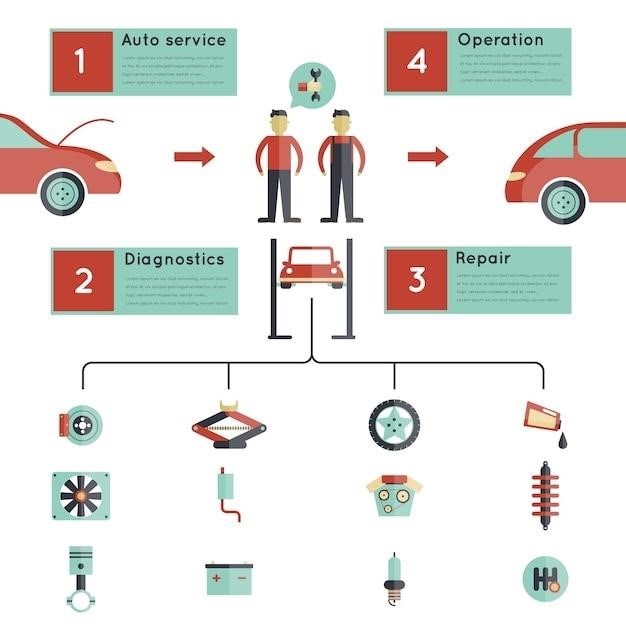This guide provides comprehensive information on maintaining your Toyota Sienna‚ covering essential aspects like regular maintenance schedules‚ recommended tasks‚ cost estimations‚ and valuable tips to ensure optimal performance and longevity.
Introduction
The Toyota Sienna is a popular minivan known for its reliability and versatility‚ making it an excellent choice for families and individuals alike. To ensure your Sienna remains in top condition and delivers optimal performance for years to come‚ it’s crucial to adhere to a regular maintenance schedule. This guide will delve into the importance of regular maintenance‚ outline a comprehensive schedule for your Sienna‚ and provide valuable tips for keeping your vehicle running smoothly. From basic services to major repairs‚ we’ll cover everything you need to know to maintain your Sienna’s value and extend its lifespan.
Importance of Regular Maintenance
Regular maintenance is not just about keeping your Toyota Sienna running smoothly; it’s about maximizing its lifespan‚ ensuring safety‚ and preserving its value. Neglecting maintenance can lead to costly repairs down the line‚ potentially impacting your budget and causing unexpected downtime. By following a consistent maintenance schedule‚ you can identify and address potential issues before they escalate‚ preventing major breakdowns and ensuring your Sienna remains reliable and efficient. This proactive approach also helps maintain your vehicle’s resale value‚ as well-maintained vehicles command higher prices in the market. Moreover‚ regular maintenance promotes safety by ensuring all critical components‚ such as brakes‚ tires‚ and lights‚ are in optimal working order‚ giving you peace of mind on the road.
Toyota Sienna Maintenance Schedule
The Toyota Sienna maintenance schedule is designed to ensure your minivan receives the necessary care at appropriate intervals. It outlines a series of services‚ ranging from basic checks to more comprehensive inspections‚ performed at specific mileage points or time intervals. This schedule serves as a roadmap for keeping your Sienna in top condition and extends its longevity. It’s essential to adhere to the recommended intervals‚ as skipping services can lead to premature wear and tear‚ potentially resulting in costly repairs later. The schedule is typically provided in your Sienna’s owner’s manual and can also be found on Toyota’s official website. The maintenance schedule includes various services‚ such as oil changes‚ filter replacements‚ fluid checks‚ and inspections of critical components like brakes‚ tires‚ and lights. It’s crucial to consult your owner’s manual or a trusted Toyota service center for detailed information regarding the specific services required for your Sienna’s model year and mileage.
Basic Service
Basic service for your Toyota Sienna typically involves routine checks and maintenance tasks that are essential for keeping your vehicle running smoothly. This service is usually recommended every 5‚000 miles or six months‚ whichever comes first. Basic service includes a comprehensive inspection of key components like engine oil levels‚ tire pressure‚ brake pads‚ and fluid levels. It also involves replacing the engine oil and oil filter‚ which helps maintain optimal engine performance and longevity. Additionally‚ technicians will visually inspect the air filter‚ spark plugs‚ and belts for any signs of wear or damage. They may also check the battery terminals and connections for corrosion and ensure the lights are functioning correctly. Basic service is a crucial part of preventative maintenance‚ helping to identify potential issues early on and ensuring your Sienna remains reliable and safe to drive.
Major Service
Major service for your Toyota Sienna is more comprehensive than basic service and involves a thorough inspection and maintenance of various vehicle systems. This service is typically recommended at intervals of 30‚000 miles or 36 months‚ depending on your driving habits and usage. Major service includes tasks like replacing the air filter‚ which helps ensure optimal airflow to the engine‚ enhancing performance and fuel efficiency. Technicians will also inspect and replace the spark plugs‚ which are responsible for igniting the fuel-air mixture in the engine. They will check and replace the brake fluid‚ which helps maintain proper braking performance. Additionally‚ major service may include a visual inspection of the suspension components‚ steering system‚ and exhaust system for any signs of wear or damage. It’s crucial to adhere to the recommended major service intervals to ensure your Toyota Sienna remains in top condition and to prevent costly repairs down the line.
Recommended Maintenance Tasks
To keep your Toyota Sienna running smoothly and reliably‚ there are several essential maintenance tasks that should be performed regularly. These tasks help ensure optimal performance‚ extend the life of your vehicle‚ and can prevent costly repairs. One of the most crucial tasks is an oil change‚ which involves replacing the old engine oil with fresh oil and a new filter. This helps lubricate engine components‚ reduce friction‚ and prevent wear and tear. Another important maintenance task is checking and topping off fluids‚ such as coolant‚ brake fluid‚ and power steering fluid. These fluids play a vital role in the proper functioning of various vehicle systems. Regularly replacing air filters‚ both the engine air filter and the cabin air filter‚ is also essential. These filters help keep the air intake clean and fresh‚ improving engine performance and cabin air quality. By adhering to a consistent maintenance schedule and performing these recommended tasks‚ you can ensure your Toyota Sienna remains in excellent condition for years to come.
Oil Change
An oil change is a fundamental maintenance task for any vehicle‚ and the Toyota Sienna is no exception. Regular oil changes are crucial for maintaining engine health and extending its lifespan. The engine oil acts as a lubricant‚ reducing friction between moving parts‚ preventing wear and tear‚ and protecting against overheating. Over time‚ engine oil degrades and loses its effectiveness‚ becoming contaminated with dirt and debris. This can lead to engine damage if not addressed promptly. A fresh oil change ensures that your engine is properly lubricated‚ reducing wear and tear and enhancing overall performance. The frequency of oil changes depends on various factors‚ such as driving conditions and the type of oil used; Consult your Toyota Sienna’s owner’s manual for specific recommendations. However‚ a general guideline is to change the oil every 5‚000 miles or six months‚ whichever comes first. It is also important to use the correct type and grade of oil for your vehicle‚ as specified in the owner’s manual.
Fluid Checks and Top-Offs
Regularly checking and topping off fluids in your Toyota Sienna is essential for maintaining its overall health and performance. Fluids play a vital role in various vehicle systems‚ including the engine‚ transmission‚ brakes‚ power steering‚ and cooling system; Over time‚ these fluids can evaporate‚ leak‚ or become contaminated‚ reducing their effectiveness. Checking fluid levels allows you to identify any potential problems early on and address them before they become major issues. Topping off fluids ensures that each system has the necessary amount of fluid to operate properly. Fluids like engine oil‚ brake fluid‚ and coolant are particularly important‚ as their depletion can lead to significant damage if not addressed. To check fluid levels‚ consult your Toyota Sienna’s owner’s manual for the location of each fluid reservoir and the appropriate levels. Always use the correct type of fluid for each system‚ as using incompatible fluids can cause damage.
Filter Replacements

Filters play a crucial role in keeping your Toyota Sienna running smoothly by removing contaminants and debris from various systems. Regular filter replacements are essential for maintaining optimal performance and extending the lifespan of your vehicle. The most common filters include the engine oil filter‚ air filter‚ cabin air filter‚ and fuel filter. The engine oil filter traps contaminants from the engine oil‚ preventing them from circulating and causing wear. The air filter prevents dirt and debris from entering the engine‚ protecting it from damage. The cabin air filter cleanses the air entering the cabin‚ improving air quality and passenger comfort. The fuel filter removes impurities from the fuel‚ ensuring proper fuel delivery to the engine. Replacing filters at recommended intervals helps maintain engine efficiency‚ fuel economy‚ and overall vehicle performance. Refer to your Toyota Sienna’s owner’s manual or consult a Toyota service center for the recommended replacement intervals for each filter. Using genuine Toyota parts for filter replacements ensures compatibility and optimal performance.
Toyota Sienna Maintenance Costs
Maintaining your Toyota Sienna involves costs associated with routine services‚ repairs‚ and parts replacements. The cost of maintenance varies based on factors like model year‚ mileage‚ location‚ and the specific services performed. According to industry data‚ a Toyota Sienna is expected to cost around $6‚177 for maintenance and repairs during its first 10 years of ownership. This figure is notably lower than the average cost for popular minivan models‚ demonstrating the Sienna’s reputation for reliability and affordability. To get a more accurate estimate of maintenance costs for your specific Toyota Sienna model year‚ you can utilize online tools like RepairPal‚ which provides national and local fair price estimates for various services. Additionally‚ contacting your local Toyota dealership or a trusted automotive repair shop can provide personalized cost estimates for specific maintenance tasks.
Finding a Toyota Service Center
Finding a qualified Toyota service center for your Sienna is crucial to ensure proper maintenance and repairs. Toyota recommends having maintenance and repairs performed by an authorized Toyota dealership for optimal results and warranty adherence. To locate your nearest authorized Toyota dealership‚ you can utilize various resources. Toyota’s Brand Engagement Center can be contacted at (800) 331-4331 for assistance. Alternatively‚ you can visit Toyota’s official website‚ www.toyota.com‚ for a comprehensive list of dealerships in your area. Additionally‚ online tools like Google Maps or Yelp can help you find nearby service centers‚ allowing you to read reviews and compare customer experiences. When choosing a service center‚ consider factors like location‚ availability‚ customer reviews‚ and the overall reputation of the facility. Remember to inquire about their expertise in servicing Toyota Sienna models and their commitment to using genuine Toyota parts.
Toyota Warranty Coverage
Understanding your Toyota Sienna’s warranty coverage is essential for ensuring peace of mind and avoiding unexpected repair costs. Toyota offers various warranty programs that protect your vehicle against defects in materials and workmanship. The standard new vehicle warranty typically covers the powertrain for 5 years or 60‚000 miles‚ whichever comes first‚ while the basic warranty covers the entire vehicle for 3 years or 36‚000 miles. Toyota also provides a corrosion perforation warranty for 5 years with unlimited mileage. Additionally‚ Toyota offers optional extended warranties that can provide coverage beyond the standard warranty period. To access detailed information about your Sienna’s warranty coverage‚ consult your owner’s manual or visit Toyota’s official website. It’s also advisable to keep track of your warranty expiration dates and ensure that all scheduled maintenance is performed by an authorized Toyota dealership to maintain warranty validity. Understanding your warranty coverage can help you make informed decisions about vehicle maintenance and ensure you’re protected against unforeseen repair expenses.

Tips for Maintaining Your Toyota Sienna
Prolonging the life and preserving the value of your Toyota Sienna requires a proactive approach to maintenance. Firstly‚ always keep your owner’s manual handy as it provides detailed information on recommended maintenance schedules‚ fluid specifications‚ and troubleshooting tips. Secondly‚ use genuine Toyota parts for all repairs and replacements. Using non-genuine parts can compromise vehicle performance and void your warranty. Thirdly‚ schedule regular service appointments at authorized Toyota dealerships. These dealerships have trained technicians familiar with your Sienna’s specific needs and use genuine Toyota parts. Finally‚ be vigilant about addressing any warning lights or unusual noises promptly. Ignoring these signs can lead to more significant problems and costly repairs. By adhering to these simple tips‚ you can ensure that your Toyota Sienna remains reliable‚ efficient‚ and enjoyable to drive for years to come.



























